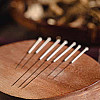How to know if your bones are thinning

We often think of broken bones as something kids get from playground adventures, but as we grow older, our bones face a different challenge. Over time, they can lose density and strength, making them more vulnerable to fractures — a condition known as osteoporosis.
This silent disease develops gradually, often without symptoms, until a sudden fall or fracture brings it to light. The good news? Advances in diagnostic tools now make it easier than ever to detect osteoporosis early and take action to protect your bone health.
Several technologies can assess bone density. The most common bone density test is known as dual energy x-ray absorptiometry (DEXA). For this procedure, a machine sends x-rays through bones in order to calculate bone density. The process is quick, taking only five minutes. And it's simple: you lie on a table while a scanner passes over your body.
While DEXA can measure bone density at any spot in the body, it is usually used to measure bone density at the lumbar spine (in the lower back), hip (a specific site in the hip near the hip joint), and femoral neck (the top of the thighbone, or femur). The test accomplishes this with only one-tenth of the radiation exposure of a standard chest x-ray.
While DEXA is considered the gold standard for osteoporosis screening, another bone density test is ultrasound. In ultrasound, sound waves measure bone mineral density at the heel, shin, or finger. The test is sometimes used at health fairs and in some medical offices.
The DEXA scan or ultrasound will give you a number called a T-score, which represents how close you are to average peak bone density. The World Health Organization has established the following classification system for bone density:
- If your T-score is –1 or greater: your bone density is considered normal.
- If your T-score is between –1 and –2.5: you have low bone density, known as osteopenia, but not osteoporosis.
- If your T-score is –2.5 or less: you have osteoporosis, even if you haven't yet broken a bone.
To learn more, buy the Harvard Special Health Report Osteoporosis: A guide to prevention and treatment.
Image: © izusek/Getty Images
Disclaimer:
As a service to our readers, Harvard Health Publishing provides access to our library of archived content. Please note the date of last review or update on all articles.
No content on this site, regardless of date, should ever be used as a substitute for direct medical advice from your doctor or other qualified clinician.















